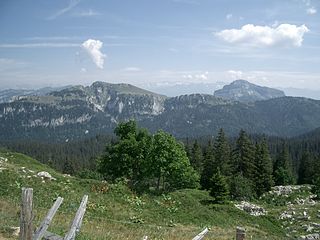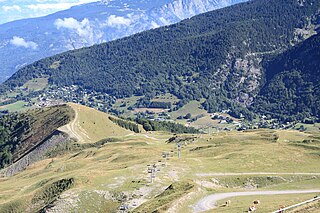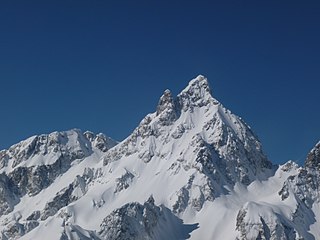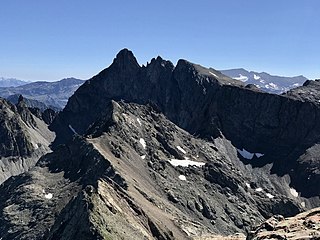
Isère is a landlocked department in the southeastern French region of Auvergne-Rhône-Alpes. Named after the river Isère, it had a population of 1,271,166 in 2019. Its prefecture is Grenoble. It borders Rhône to the northwest, Ain to the north, Savoie to the east, Hautes-Alpes to the south, Drôme and Ardèche to the southwest and Loire to the west.

The Chartreuse Mountains are a mountain range in southeastern France, stretching from the city of Grenoble in the south to the Lac du Bourget in the north. They are part of the French Prealps, which continue as the Bauges to the north and the Vercors to the south.

The Vercors Massif is a range in France consisting of rugged plateaus and mountains straddling the départements of Isère and Drôme in the French Prealps. It lies west of the Dauphiné Alps, from which it is separated by the rivers Drac and Isère. The cliffs at the massif's eastern limit face the city of Grenoble.

Écrins National Park is a French national park located in the southeastern part of France in the Dauphiné Alps south of Grenoble and north of Gap, shared between the departments of Isère and Hautes-Alpes. The park is one of eight regions in France designated as French national parks.

The Isère is a river in the Auvergne-Rhône-Alpes region of southeastern France. Its source, a glacier known as the Sources de l'Isère, lies in the Vanoise National Park in the Graian Alps of Savoie, near the ski resort in Val-d'Isère on the border with Italy. An important left-bank tributary of the Rhône, the Isère merges with it a few kilometers north of Valence.

The Romanche is a 78.3-kilometre (48.7 mi) long mountain river in southeastern France. It is a right tributary of the Drac, which is itself a tributary of the Isère. Its drainage basin is 1,221 km2 (471 sq mi). Its source is in the northern part of the Massif des Écrins, Dauphiné Alps. It flows into the Drac in Champ-sur-Drac, south of Grenoble. The road from Grenoble to Briançon over the Col du Lautaret runs through the Romanche valley. There are several mountain and ski resorts in the valley, including Alpe d'Huez, La Grave and Les Deux Alpes.

The Drac is a 130-kilometre (81 mi) long river in southeastern France. It is a left tributary of the river Isère. It is formed at the confluence of the Drac Noir and the Drac Blanc, which both rise in the southern part of the Massif des Écrins, high in the French Alps. It flows through several reservoirs on its course, including the Lac de Monteynard-Avignonet. It flows into the Isère at Grenoble. Its major tributary is the Romanche.
The following is a list of the 29 cantons of the Isère department, in France, following the French canton reorganisation which came into effect in March 2015:

Matheysine is a French Natural region located in the Alps at the south of the Isère département. Its relief is a plateau surrounded by mountains. Matheysine is also called Plateau Matheysin.

Biviers is a commune in the Isère département in southeastern France.

Livet-et-Gavet is a commune in the Isère department in southeastern France.

The Grésivaudan is a valley of the French Alps, situated mostly in the Isère. Etymologically, Graisivaudan comes from roots meaning "Grenoble" (Gratianopolis) and "valley". It comprises the alluvial plain of the river Isère from Grenoble to the confluence of the Arc; or, more recently, the entire valley of the Isère from Tullins to Albertville. The stretch from Tullins to Grenoble is now the Bas-Grésivaudan and that between Grenoble and Albertville is the Haut-Grésivaudan.

L'Oisans is a region in the French Alps, located in the départements of l'Isère and Hautes-Alpes, and corresponding to the drainage basin of the River Romanche and its tributaries. Between Livet-et-Gavet and Le Bourg-d'Oisans, the Romanche forms a deep gorge.

Alpe du Grand Serre is a ski resort located in the French Dauphine Alps in Isère département, upon the commune of La Morte, sitting at 1368m. The village itself is located at the summit of a mountain pass at the gates of the Oisans valley, between the Romanche valley and the Roizonne valley. Neighbouring mountains are the Taillefer (2857m) and the Grand Serre summit (2141m). It remains a small mountain village with traditional alpine buildings and atmosphere. Thus, it is mostly visited by local people and families from the Grenoble urban area.

Les Sept Laux is a group of three winter sports resorts of the Alps located in the Belledonne (Isère) about 35 km (22 mi) from Grenoble and 50 km (31 mi) from Chambery in the communes of Theys, Les Adrets and Le Haut-Bréda.

Henry or Henri Duhamel was a French mountaineer, author and skiing pioneer. He introduced the practice of skiing to his circle of friends at Grenoble, leading to the creation of the first ski club in France.

The Grand Pic de Belledonne is the highest mountain in the Belledonne massif in the Dauphiné Alps at 2,977 metres (9,767 ft).

Croix de Belledonne, at 2,926 metres (9,600 ft), is one of the highest points in the Belledonne range in the French Alps, close to the highest summit in the range, Grand Pic de Belledonne at 2,977 metres (9,767 ft). The name derives from the cross erected on the summit.
The Isère-Drac-Romanche Departmental Association is a public administrative establishment in France formed by the Conseil d'État in 1936. Its purpose is to maintain the system of flood-risk protection in the plains of the Isère, Drac, and Romanche rivers by preserving the integrity of embankments and their associated works. The organization performs all research and labor necessary for their preservation and keeps the system under constant surveillance in order to guarantee its efficiency in protecting the land and property at stake behind the embankments.

During the Second World War, the Oisans maquis was an important center for the French Resistance, in the Oisans region between the Belledonne range and Grenoble to the north, the Grandes Rousses massif of the Alps and the Croix de Fer pass to the east, the Drac valley to the west and the Barre des Écrins and the Provencal Alps to the south.































